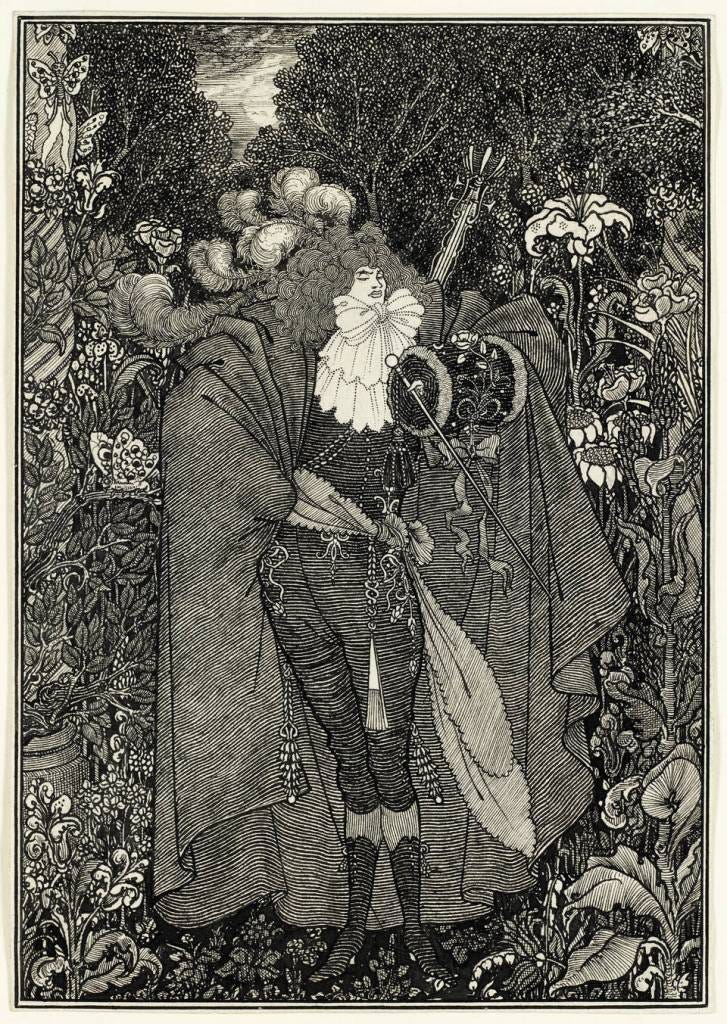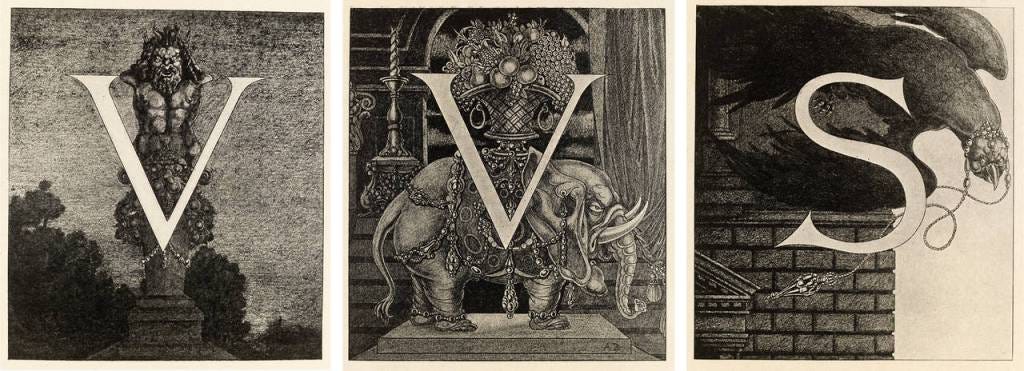The Questing Beast and the Curious Conversion of Aubrey Beardsley
An essay on the work and conversion of a grotesque 19th century artist.
Aubrey Beardsley, born in 1872, began suffering from tuberculosis at age seven. His life expectancy was thrown into uncertainty. Despite this, he was given an excellent education in art, literature, and music by his father. He grew up to be an influential artist and illustrator during the fin-de-siècle, and he made important contributions to the world of art at the time. His illustrations were primarily done with black ink and are inspired in many ways by Japanese woodcuts. Japonism is likely the reason for this, as fascination with Japanese art and culture was in full swing during Beardsley's lifetime thanks to the country opening up to the West in the 1850s.
His career began with a commission for Le Morte d'Arthur by Thomas Malory in 1893. These illustrations are how I first learned of Beardsley, as I own a copy of Le Morte d'Arthur published by Flame Tree Publishing, which uses Beardsley's art. I immediately fell in love with Beardsley's style as I have an appreciation for Art Nouveau and the pre-Raphaelite movement.
These images evoke a wonderful feeling of the mystical, the mythic, and the legendary for me. The frame of the illustrations are flowery and lush to match the environment in which the characters are in. Each blade of grass seems to have been given special attention, the forest feels dense and dark, and Arthur's armor is put on full display.
One particular illustration of Beardsley stood out, though, that being 'How King Arthur saw the Questing Beast.'
Thomas Malory drew from the Post-Vulgate cycle of the Questing Beast and used it in Le Morte d'Arthur. He writes that the beast, making the sound of a great number of hounds, appears to the young king Arthur as he sits under a tree, just after he had an affair with his half-sister Morgause. That affair would produce Mordred, the bastard son and traitor who would eventually bring about death and destruction to Arthur and the entire realm. This illustration depicts Arthur seeing the beast drinking from a pool after he wakes from a dream which foretold Mordred's actions.
The beast leaves and King Pellinore arrives not long after, explaining that he and his family are on a quest to hunt and kill the beast. Merlin also comes to the scene and reveals that the beast had a human mother, a princess who had lusted after her brother. A devil promised the girl that the boy would love her if she only slept with the devil, but then the devil convinced her to accuse her brother of rape. The boy, at the king's command, was torn apart by dogs as punishment. Just before he died, however, the boy prophesied that the girl would birth an abomination that makes the same sound as the dogs just before they tore him apart.
Palamedes, a Saracen knight, also hunts the Questing Beast to no avail, a parallel to his futile love of Tristan's Iseult. The Post-Vulgate cycle has Palamedes converting to Christianity, which brings him relief from all his worldly hardships and fruitless ventures. Only after this does he finally slay the beast during the Grail Quest.
After seeing these illustrations, I decided to look up Aubrey Beardsley to learn about him and see more of his art. I was, admittedly, surprised. On the one hand, Beardsley produced some fine illustrations which I enjoy, such as this one:

On the other hand, he is most known for his grotesque, dark, and perverted art. Some of his most sexual and provocative illustrations were commissions for Wilde's Salome. However, nothing quite compares to his illustrations for Aristophanes' Lysistrata. Respecting his dying wish, which you will learn of later (and considering their nature), I will not display or describe these works; suffice it to say they are nothing less than obscene and pornographic pieces. Edward Burne-Jones called Beardsley's art “detestable...more lustful than any I've seen – not that I've seen many such.” Beardsley took pride in his decadence though, saying in 1897:
“I have one aim – the grotesque. If I am not grotesque, I am nothing.”
Apart from his art, Beardsley was a dandy and eccentric both publicly and privately. This aligned with the character of his social life, as a number of his most notable patrons were heavily interested in pornography, erotic art, and homosexuality. He was very close with Oscar Wilde and Andre Raffalovich, notorious homosexual figures of the era. Beardlsey himself often cross-dressed with his sister, Mabel, and was clearly sexually deviant. There were rumors of him being an outright homosexual due to this and his company with Wilde's group, but these rumors are not a hundred percent confirmed. There were also speculations that Beardsley had an incestuous relationship with his sister which resulted in a miscarriage. In December 1896, the year after Oscar Wilde was charged and jailed for gross indecency, Beardsley was hit with a terrible hemorrhage.
Then, in March 1897, something miraculous happened; Beardsley converted to Catholicism. That autumn, he began work on another project creating illustrations for Volpone. These were going to be of a new style and his greatest ever. He finished only a few, seen below.

Finally, just eight days before he died on March 16, 1898, Aubrey Beardsley wrote a curious letter to his publisher. It reads:
Jesus is our Lord and Judge. Dear friend, I implore you to destroy all copies of Lysistrata and bad drawings…By all that is holy - all obscene drawings. Aubrey Beardsley. In my death agony.
He died with a rosary and crucifix clasped in his hands.
His publisher did not honor his request. This may be seen as fortunate or unfortunate depending on whether you believe art ought to be preserved, or whether a dying man's pious wishes ought to be granted.
All this caused me to wonder: how and why did Aubrey Beardsley go from being a grotesque, scandalous, and offensive artist—who created illustrations of an obscene and pornographic nature—to being a Roman Catholic in England?
As I looked back on all I’d learned, I couldn’t help but think that perhaps the answer lies in his art—especially the Arthurian legend behind the Questing Beast. Indeed, I believe that his illustration of this scene is his most important and revealing work ever, with the legend containing striking parallels to Beardsley's own life. While it cannot be definitively proven, I believe this illustration and its meaning is a reflection of his own inner struggle with lust and the sexual relationship he had with his sister, which ended in miscarriage.
In the legend, both Arthur and the princess Merlin speaks of have affairs with their kin which produces a monstrous offspring. In Arthur's case, it is his traitor son who brings about the downfall of the kingdom. In the princess's case, it is a mythical beast which leads King Pellinore and the Knight Palamedes on futile quests. In Beardsley's case, he lusts after his own sister and perhaps goes even further than lust. This produces either a literal or metaphorical miscarriage as he leads a life of sin and degeneracy. Just as Palamedes was only able to slay the beast and put his earthly troubles with lust behind him after his conversion to Christianity, so Beardsley's sinful lifestyle came to an end after his late conversion to Catholicism. I believe Beardsley realized the futility of his work as well as the wickedness of his actions, perhaps in conjuction with his declining health and the looming inevitability of death. I suspect he felt guilty about the affair even before his conversion, as it is said he was always a deeply religious man, as well as a depressed one. Because of this realization and guilt, Beardsley followed in the righteous footsteps of Palamedes and turned towards the Lord rather than worldly pleasure and projects. His letter requesting the destruction of his “bad” and “obscene drawings” is proof of his disdain for his past work and of a genuine conversion.
What is interesting is that Beardsley was not alone in his conversion. Andre Raffalovich converted to Roman Catholicism in 1894, as did Oscar Wilde in 1900. It is not out of the question that Raffalovich influenced Beardsley, or that the two of them influenced Wilde. Some may debate how genuine either one of these men were in their conversion, but I am not in the business of saying a man’s late-life conversion was disingenuous. Even the laborers who arrive near the end of the day receive a fair wage.
The illustration of Arthur and the Questing Beast is representative of his life's struggles, the story surrounding the art providing deep insight into his suffering. A man, guilty of lust and detestable sexual depravity, who led a futile life which seemingly bore no good fruit, found salvation and peace in Christ and His Church.
This poetic parallel is fitting for an artistic genius such as Beardsley. I hope that, if he is in Eternal Paradise, he prays for all those who struggle with similar sins. His story, and the story of Wilde and Raffalovich, show that even the most debauched and sexually degenerate individuals of any age are capable of turning to Christ. Perhaps this may serve as a lesson for Christians today who feel that sexuality has never been in such a crisis or that those who struggle with their sexuality are simply beyond saving.
Sources:
https://www.thefreelibrary.com/Beardsley+and+the+art+of+decadence%3B+Aubrey+Beardsley.+By+Matthew...-a060788352
https://books.google.com/books?id=R81qhmUO2BoC&dq=Mabel+Beardsley+incest+sister&pg=PA194#v=onepage&q&f=false
https://www.britannica.com/biography/Aubrey-Beardsley
https://www.thecollector.com/aubrey-beardsley-art-nouveu/
https://en.wikipedia.org/wiki/Aubrey_Beardsley







Aristophanes' Lysistrata, like all Greek comedy would have been performed with the actors wearing huge artificial phalluses. Greek humor was vulgar and bawdy. Beardsley would have known this, hence the grotesque mashup of Greek costumery and 18th century costumes in his Lysistrata illustrations. When I learned about this detail of the original comedy costumery, it made these bizarre illustrations somewhat more comprehensible, though his desire to suppress them was a healthy impulse. Even as art, they are far from his best work, and we would have been better off if he had made better use of his talent. His late conversion is a happy end to a troubled life.
Very interesting. I was actually working on an article about Beardsley myself, and was going to talk about his unfinished Tannhäuser work, as well as many of the points you mentioned, up until his conversion. I feel a little disappointed that someone beat me to it, and that they wrote it so well I don’t have very much to say that’s original.